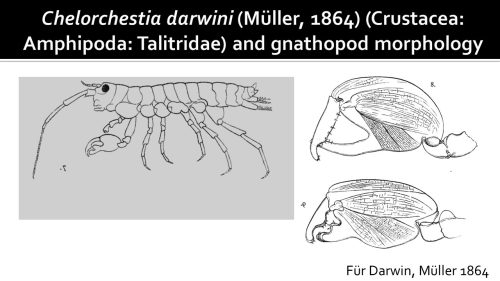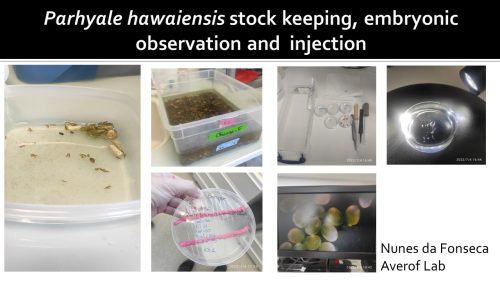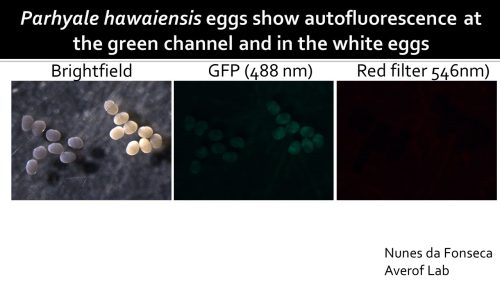Brazilian-France European Research Council (ERC) connections: great opportunities to foster an international Evo-Devo
Posted by RODRIGO NUNES FONSECA, on 14 March 2023
Latin-America is well-known as one of the largest hotspots of biodiversity, inspiring a generation of important naturalists during the emergence of comparative developmental biology in the 19th century. One of these naturalists, the German Johann Friedrich Theodor Müller (Fritz Müller), named the “Prince of Observers” by Charles Darwin, produced seminal work on the evolution of animals and plants in their natural environment1. The reciprocal admiration of Fritz Müller for Darwin can be seen in the name of the amphipod Chelorchestia darwini (Müller, 1864) (Crustacea: Amphipoda: Talitridae – Figure 1) and in the large number of letters exchanged between them.

Figure 1: The amphipod Chelorchestia darwini (Müller, 1864) (Crustacea: Amphipoda: Talitridae. Left – a male of C. darwini. Right – Fritz Müller showed that adult males from this species display two types of morphology in the gnathopod 2.
In Für Darwin2 (1864, For Darwin or Facts and Arguments for Darwin), Fritz Müller chose the crustaceans, a diverse and well-established taxonomic group at that time, to develop a theory of phylogenetic (genealogical) relationships among crustacean families, genera and species, particularly taking into account observations on embryonic and post-embryonic development in the natural environment.

Figure 2: Parhyale hawaiensis in laboratory culture, embryonic observation and manipulation.
Two hundred years after the birth of Fritz Müller3 (1822), I had the great opportunity to join a vibrant laboratory specialized in crustacean regeneration and evo-devo using the emerging model species Parhyale hawaiensis4. Interestingly, between 1888-1890 Fritz Müller studied the complete limb regeneration of Ayoida Potimirim (Crustacea; Multicrustacea; Decapoda; Atyidae) in their natural environment and found that several molts are required before the limbs acquire their original size. Müller stated “here [in limb regeneration] ontogeny recapitulates phylogeny” in an allusion to Haeckel´s biogenetic law5. The Averof laboratory6, at the Institut de Génomique Fonctionnelle de Lyon7, in France recently showed that the transcriptional signal from molting makes more difficult to study transcriptional profiles of regeneration8, but whether regeneration is dependent or controlled by molting is currently unknown.
Our group in Brazil has been interested in studying the evolution of early embryonic patterning, particularly of non-conventional arthropod models such as the kissing bug and the bovine tick, among others, but we particularly lacked crustacean representatives, thus far. In Lyon, I was exposed to a very friendly and productive group and was able to learn the laboratory routine of this emerging model system for development and regeneration (Figure 2 and 3).

Figure 3: Parhyale hawaiensis two cell-stage white-eggs display more intense auto-fluorescence at the green channel than purple eggs. It is also possible that the purple eggs absorbs the energy at this channel. No auto-fluorescence was observed at the red channel.
During these six months, I also started to investigate the role of the pioneer transcription zelda (zld) factor in this amphipod species. In fruit flies, zld is required for the maternal zygotic transition (MZT) and regulates hundreds of genes during the genome zygotic activation (ZGA) process. Interestingly, zld´s phylogenetic roots dates to the common ancestor of Pancrustacea (the monophyletic group including insects and crustaceans)9. Since my host lab had already developed genetic tools for transgenesis and transcriptional profiling in Parhyale (bulk and single-cell datasets for Parhyale leg development and regeneration)10, I could profit from these resources and start to draw hypotheses on the putative roles of zld in this amphipod. I plan to further develop these ideas now back in Brazil!
In Brazil, I was very lucky that Professor Gisela Umbuzeiro, a well-established ecotoxicologist, has already established a large colony of Parhyale11, and that Prof. Luciano Fisher from NUPEM-UFRJ and Cristiana Serejo from the National Museum-UFRJ had recently published a guide on naturally occurring amphipod species12 with the rocky shore fauna of Brazil. Although Parhyale hawainesis was not identified in this survey, other amphipods of the same family (Infraorder Talitridae, Hyalidae) are present and associated with different habitats. The rocky shore fauna of Macaé, Rio de Janeiro is a particularly interesting spot for biodiversity, since it is in the most prominent area of oil exploitation in Brazil and harbors the largest protected sandbank park in the country . Thus, the CNPq/FAPERJ/ERC grant provided an opportunity to start an integrated Eco-Evo-Devo approach, connecting laboratory experiments with field work. If alive, I guess Fritz Müller may have been interested to follow these experiments.
Rodrigo Nunes-da-Fonseca (https://nunesdafonsecalab.com/) is an Associate Professor at the Institute of Biodiversity and Sustainability – NUPEM (https://nupem.ufrj.br/english-version/) of the Federal University of Rio de Janeiro. He is a Scientist of Our State FAPERJ and CNPq researcher. He was awarded with an ERC/FAPERJ/CNPq scholarship to join Averof´s team for six months during the second half of 2022.
Acknowledgments: I would like to thank Michalis Averof and all the members of the laboratory for the remarkable six-months I spent in Lyon, France, during my sabbatical.
References/Further Reading:
1. WEST, David A.., Darwin’s Man in Brazil – The Evolving Science of Fritz Müller. University Press of Florida, Gainesville, FL., 2016316p. ISBN: 9780813062600.
2. Müller F (1864) Für Darwin. Wilhelm Engelmann, Leipzig, 91 p.
3. Leonardo Augusto Luvison Araujo, Fritz Müller: 200 years of a pioneer evolutionist, Biological Journal of the Linnean Society, Volume 137, Issue 4, December 2022, Pages 737–739, https://doi.org/10.1093/biolinnean/blac124
4. Paris M, Wolff C, Patel NH, Averof M. The crustacean model Parhyale hawaiensis. Curr Top Dev Biol. 2022;147:199-230. doi: 10.1016/bs.ctdb.2022.02.001. Epub 2022 Mar 14. PMID: 35337450.
5. Müller, Fr., Haeckel’s biogenetisches Grundgesetz bei der Neubildung verlorener Glieder, in: Kosmos. 8. Bd. p. 3S8. *Note that the the fact that Fritz Müller cited Haeckel here does not assume that Haeckel was correct in the current knowlegde.
6. https://www.averof-lab.org/
8. Sinigaglia C, Almazán A, Lebel M, Sémon M, Gillet B, Hughes S, Edsinger E, Averof M, Paris M. Distinct gene expression dynamics in developing and regenerating crustacean limbs. Proc Natl Acad Sci U S A. 2022 Jul 5;119(27):e2119297119. doi: 10.1073/pnas.2119297119. Epub 2022 Jul 1. PMID: 35776546; PMCID: PMC9271199.
9. Ribeiro L, Tobias-Santos V, Santos D, Antunes F, Feltran G, de Souza Menezes J, et al. (2017) Evolution and multiple roles of the Pancrustacea specific transcription factor zelda in insects. PLoS Genet 13(7): e1006868. https://doi.org/10.1371/journal.pgen.1006868
10. https://www.averof-lab.org/pages/2923-resources
11. dos Santos, A. Botelho, M.T et al., The amphipod Parhyale hawaiensis as a promising model in ecotoxicology, Chemosphere, Volume 307, Part 2, 2022, 135959,ISSN 0045-6535, https://doi.org/10.1016/j.chemosphere.2022.135959.
12. Intertidal Rocky Shore Fauna. Vol 1. Crustacea Decapoda and Peracarida, Rio de Janeiro, Brazil. https://www.researchgate.net/publication/369021929_Intertidal_Rocky_Shore_Fauna_Vol_1_Crustacea_Decapoda_and_Peracarida_Rio_de_Janeiro_Brazil


 (No Ratings Yet)
(No Ratings Yet)